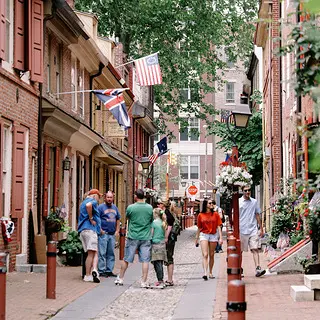
Building Stronger Communities
Historic Neighborhoods of Philadelphia
From the cobblestone charm of Old City to the industrial heritage of Kensington, from the legacy of freedom in Germantown to the arts scene of Manayunk, Philadelphia’s tapestry of historic neighborhoods is the heart and soul of a city that gave birth to a nation and still has independence, pride, and a spirit of brotherly love running through its veins.
Compared to areas in Philadelphia with large, new structures, the city’s character-rich blocks of older, smaller, mixed-aged buildings contain more than twice the population density and twice the number of jobs in small and new businesses. These historic neighborhoods and districts have attracted nearly two billion dollars in private investment dollars through the federal historic tax credit.
The most vibrant and diverse neighborhoods in Philadelphia contain a mix of older, small-scale buildings of varying ages. These areas tend to have more small, local, and women- and minority-owned businesses, more diversity in housing types and costs, and more activity at all times of the day.
Almanac of American History
Philadelphia is home to a wealth of architectural and historic resources from the 17th century through the 21st. The city is considered a veritable almanac of American history in its wide architectural spectrum and in its diverse range of stories. Every district and neighborhood in Philadelphia has something unique to offer, from expansive warehouses to iconic historic sites to architecturally defining rowhouses.

photo by: Neal Santos
Powelton Village

photo by: Neal Santos
Pine Street in Washington Square West

photo by: Neal Santos
Chester Avenue and West 45th Street in West Philadelphia

photo by: Neal Santos
South 2nd Street in Society Hill

photo by: Neal Santos
Jewelers Row
Every area also presents its own significant challenges in preservation, reuse, and conservation. Fishtown and Pennsport, once working-class districts of modest rowhouses, face gentrification and significant development pressure. Early suburbs such as Spruce Hill and Powelton Village are facing displacement and demand for student housing. Nineteenth-century garden suburbs such as Tulpehocken, Overbrook Farms, Pelham, and Oak Lane retain their impressive architecture, but the large houses present reuse challenges. Villages such as Ridge, Germantown, Oxford, and Frankford suffer from sprawl, and in many cases disinvestment. Commercial districts such as Jewelers Row and the Italian Market have deep social and cultural significance, yet lack any level of protection.
These and other largely undesignated neighborhoods make up Philadelphia’s extraordinary collection of historic and old housing stock and significant structures. Without improved preservation methods contributing to a healthier and more sustainable city, large sectors of Philadelphia will remain vulnerable in the future.
Regrowth, Reuse, and Revitalization
Despite significant preservation challenges, Philadelphia continues to be a city that is not only worth saving, but that should be protected for the future. In June 2017, the National Trust partnered with the Preservation Alliance for Greater Philadelphia and the City of Philadelphia to give the city access to a unique set of preservation tools, policies, and resources to foster growth, innovation, sustainability, and inclusivity.
Philadelphia Mayor James Kenney’s Historic Preservation Task Force was created with the National Trust to explore preservation tools that encourage growth without compromising each neighborhood’s authentic character. As a direct result of this task force, new tools for building stronger communities in Philadelphia were introduced in late 2019: reducing parking requirements for some historic properties, allowing accessory dwelling units (ADUs), zoning relief to encourage investment in historic properties, and demolition review in Neighborhood Conservation Overlay Districts.
Together with partners—including Philadelphia’s government, preservation societies, and residents—the National Trust has helped ensure that the benefits of revitalization extends to all Philadelphia residents and neighborhoods.
Take an architectural walking tour of historic Philadelphia.
Plan Your VisitSupport our work to save places that matter.
Donate TodayStay connected with us via email. Sign up today.
Related Stories
-
Preservation Magazine The 2025 Winners of the Richard H. Driehaus Foundation National Preservation Awards -
Preservation Magazine A Uniquely Skewed Bridge in Philadelphia's Fairmount Park is Restored -
Preservation Magazine Investing in the Future: NTCIC's Impact on Three Revitalized Historic Places
Explore More Places
Now is the time for preservation advocates to engage directly with your members of Congress and elevate the importance of historic preservation in your communities.
Get Started
.webp)


